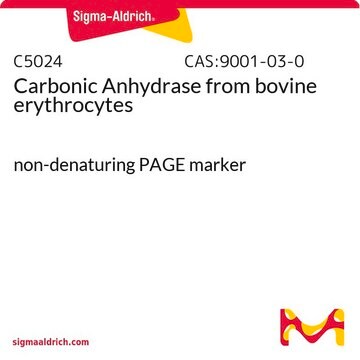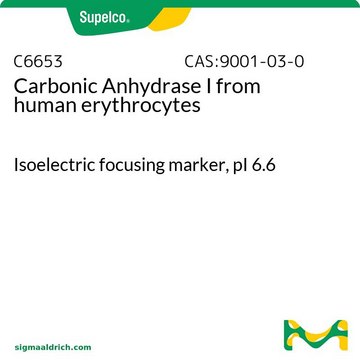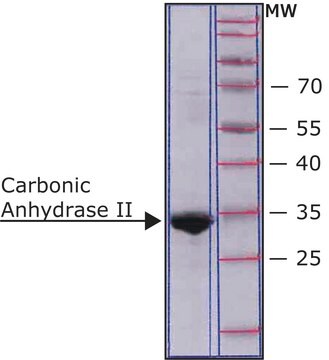Key Documents
C2273
Carbonic Anhydrase from bovine erythrocytes
For use as a marker in SDS-PAGE
Synonim(y):
Carbonate Dehydratase, Carbonate Hydrolyase
About This Item
Polecane produkty
pochodzenie biologiczne
bovine erythrocytes
Poziom jakości
Postać
powder
masa cząsteczkowa
~29 kDa
opakowanie
vial of 5 mg
temp. przechowywania
2-8°C
Szukasz podobnych produktów? Odwiedź Przewodnik dotyczący porównywania produktów
Opis ogólny
Zastosowanie
- as a component of nine-protein mixture for the comparative proteomic mass spectrometry analysis of bovine brain samples
- as a molecular marker in gel filtration chromatography
- as a standard protein to test the recovery of CMA/20 microdialysis probe
Działania biochem./fizjol.
Definicja jednostki
Hasło ostrzegawcze
Danger
Zwroty wskazujące rodzaj zagrożenia
Zwroty wskazujące środki ostrożności
Klasyfikacja zagrożeń
Resp. Sens. 1
Kod klasy składowania
11 - Combustible Solids
Klasa zagrożenia wodnego (WGK)
WGK 3
Temperatura zapłonu (°F)
Not applicable
Temperatura zapłonu (°C)
Not applicable
Środki ochrony indywidualnej
Eyeshields, Gloves, type N95 (US)
Certyfikaty analizy (CoA)
Poszukaj Certyfikaty analizy (CoA), wpisując numer partii/serii produktów. Numery serii i partii można znaleźć na etykiecie produktu po słowach „seria” lub „partia”.
Masz już ten produkt?
Dokumenty związane z niedawno zakupionymi produktami zostały zamieszczone w Bibliotece dokumentów.
Klienci oglądali również te produkty
Nasz zespół naukowców ma doświadczenie we wszystkich obszarach badań, w tym w naukach przyrodniczych, materiałoznawstwie, syntezie chemicznej, chromatografii, analityce i wielu innych dziedzinach.
Skontaktuj się z zespołem ds. pomocy technicznej












